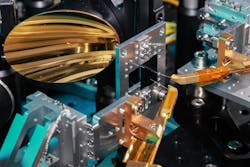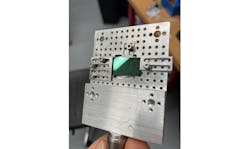A team of researchers led by Professor Cristina Benea-Chelmus of École Polytechnique Fédérale de Lausanne (EPFL; Lausanne, Switzerland) and Harvard University (Cambridge, MA) recently created a way to use integrated photonics devices not only to generate terahertz waves, but also to tailor their frequency, wavelength, amplitude, and phase (see Fig. 1).
It’s a big step toward finally being able to exploit the terahertz gap that exists between about 0.3 to 30 THz on the electromagnetic spectrum—frequencies too fast for electronics and too slow for optics and imaging—and it opens the door to applications within the optical and electronic realms.
This serendipitous collaboration started in the cleanroom at Harvard when Amirhassan Shams-Ansari, now a postdoctoral fellow in Marko Lončar’s group, then a senior Ph.D. student, met Benea-Chelmus, a postdoc at the time in Federico Capasso’s group.
“After several discussions, it was clear to us that we needed to do something extraordinary to combine her expertise in terahertz with our thin-film lithium niobate nanophotonics capabilities,” says Shams-Ansari.
Lithium niobate in its bulk form was already endorsed by the community, so they were confident a thin-film version of the same material would provide an excellent platform for terahertz emission.
“The prospect of creating miniaturized terahertz devices from thin-film lithium niobate was so exciting,” says Benea-Chelmus. “We did back-of-the-envelope calculations showing it should work, but we didn’t know if it eventually would—many things needed to be built from scratch.”
Terahertz is “the domain with huge unleashed applications—which can have a particularly significant impact in medicine and communications,” says Shams-Ansari. “Generating terahertz on integrated photonics thin-film lithium niobate chips would open new opportunities with unprecedented performance. For instance, a noninvasive way to analyze tumors; they contain a lot of water, which has resonances in the terahertz.”
A thin-film lithium niobate platform
When Benea-Chelmus and her team, including Alexa Herter, currently a Ph.D. student at ETH Zurich (Switzerland), were exploring ways to characterize terahertz waves, they realized most techniques still rely on macroscopic crystals.
“Early work showed integrated platforms bring benefits in terms of sensitivity because they allow control of terahertz and optical waves at the nanoscale,” says Herter. “Lithium niobate seemed like a perfect fit, because waveguides in this platform are excellent and terahertz antennas can be seamlessly patterned around them.”
So they started exploring how or whether a near-infrared (near-IR) pulse can generate terahertz radiation inside a thin-film lithium niobate waveguide.
Why lithium niobate? “The high electro-optic coefficient of lithium niobate is widely used for the modulation of optical signals up to gigahertz frequencies—especially at the telecommunications wavelength,” explains Herter. “On thin-film lithium niobate, complex photonic circuit designs are possible due to the extremely low optical waveguide losses.”
The team’s lithium niobate circuit is etched at the nanometer scale, which streamlines their platform. And a silicon substrate makes the device suitable for integration into electronic and optical systems.
Where do optical fibers come in? Optical signals need a medium such as optical fibers to propagate. Electronic signals have similar requirements, but can be transported with wires or an antenna to travel in the free space.
Terahertz waves can’t be generated via standard electronic sources “because they’re too fast,” says Shams-Ansari. “Also, there are no compact sources such as lasers to emit at frequencies in the band below 1 THz. Quantum-cascade lasers typically operate at larger frequencies, and gas lasers are still bulky at the moment, so scientists have come up with innovative techniques to generate these waveforms.”
For their devices, a nonlinear effect of optical rectification is used to generate terahertz radiation. “Typically, for optical rectification, high-intensive near-IR pulses are focused into a bulk nonlinear crystal,” Herter says. “The nonlinear mixing of near-IR frequencies then generates radiation within the spectral bandwidth of the pump pulses—and in the case of femtosecond pulses, the generated frequency reaches the terahertz range.”
By coupling femtosecond pulses generated in a fiber laser into the thin film lithium niobate waveguide (see Fig. 2), the researchers can induce nonlinear terahertz polarization. “Terahertz antennas placed along the waveguide ‘guide’ the terahertz radiation at the required center frequency into free space,” Herter says.In other words: the team combines optical rectification—a nonlinear optical effect typically used in terahertz time-domain spectroscopy—with the integrated platform of thin-film lithium niobate. “Terahertz antennas printed along the waveguides allow us to couple the generated radiation into free space,” Herter adds.
On their thin-film lithium niobate platform, the researchers can make chip-scale optical fibers 1/100 of the thickness of a human hair.
“It allows light to travel across the chip while interacting with our platform material, a well-known nonlinear material,” Shams-Ansari says. “Now we can make waveguides with specific dimensions. When the laser pulse—with a frequency of hundreds of terahertz—travels and interacts with them, it generates nonlinear polarization, resulting in a spectrum spanning from 0 to a few terahertz. To be able to measure this signal, we make tiny antennas sandwiching the waveguide and ‘emit’ the terahertz off that chip.”
Terahertz radiation
Initially, Herter was astonished to simply see the emission of terahertz radiation from the very first device. “The basic effect—optical rectification—is usually used in combination with very intense near-IR laser signals with pulse energies in the range of millijoules up to joules,” she says. “The pulse energy we have inside the thin-film lithium niobate waveguide measures only 100 picojoules at the moment, so we weren’t 100% sure whether it was already sufficient to generate detectable terahertz radiation.”
While studying the emitted radiation and designing new devices, Herter recognized their device’s potential—especially in terms of its flexibility. “Beyond generating terahertz radiation on this platform, we can control the terahertz waveform in a unique number of degrees of freedom,” she says.
It may find applications in telecommunications, or “medical diagnostics to analyze the composition of tissues in breast cancers, skin cancers, tumors, or burn wounds,” Shams-Ansari says.
Targeting better efficiency and a broader emission wavelength
The next step is “a more complicated system with better efficiency and a broader emission wavelength with integrated sources,” says Shams-Ansari. “The big challenge is to put more light into these devices to enable more robust designs.”
To get there, the team is currently working on two fronts. “On one hand, we’re exploring whether detectors can be realized on the same platform,” says Herter. “On the other hand, further work will focus on consolidating this initial work and increasing the generated terahertz power and extent of the complexity of the integrated circuits for custom-tailored terahertz generations. Eventually, we can imagine having a complete terahertz spectroscopy system in thin-film lithium niobate.”
The most exciting aspect of this work for Benea-Chelmus is the prospect of having miniaturized terahertz sources on the same chip, alongside photonics. “We can dream of using them for electro-optic frequency combs or injection locking of other optical sources at terahertz repetition rates,” she says. “The optical-electronic interplay enables a very diverse photonic palette that’s inaccessible by photonics alone. Although we have a long path ahead, in the future, their compactness may also be beneficial to easily interface them with quantum systems that have extremely low dimensionality, to drive these transitions into well-controlled states.”
FURTHER READING
A. Herter et al., Nat. Commun., 14, 11 (2023); https://doi.org/10.1038/s41467-022-35517-6.


